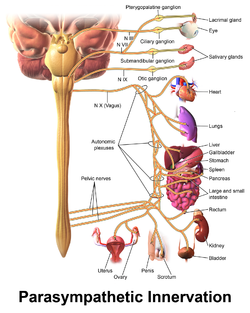Our website is made possible by displaying online advertisements to our visitors.
Please consider supporting us by disabling your ad blocker.
Parasympathetic nervous system
This article needs additional citations for verification. (November 2011) |
| Parasympathetic nervous system | |
|---|---|
 Autonomic nervous system innervation, showing the parasympathetic (craniosacral) systems and target organs. | |
| Details | |
| Synonyms | Parasympathetic autonomic nervous system |
| Identifiers | |
| Latin | pars parasympathica divisionis autonomici systematis |
| Acronym(s) | PSNS or PANS |
| MeSH | D010275 |
| TA98 | A14.3.02.001 |
| TA2 | 6661 |
| FMA | 9907 |
| Anatomical terminology | |
The parasympathetic nervous system (PSNS) is one of the three divisions of the autonomic nervous system, the others being the sympathetic nervous system and the enteric nervous system.[1][2]
The autonomic nervous system is responsible for regulating the body's unconscious actions. The parasympathetic system is responsible for stimulation of "rest-and-digest" or "feed-and-breed"[3] activities that occur when the body is at rest, especially after eating, including sexual arousal, salivation, lacrimation (tears), urination, digestion, and defecation. Its action is described as being complementary to that of the sympathetic nervous system, which is responsible for stimulating activities associated with the fight-or-flight response.
Nerve fibres of the parasympathetic nervous system arise from the central nervous system. Specific nerves include several cranial nerves, specifically the oculomotor nerve, facial nerve, glossopharyngeal nerve, and vagus nerve. Three spinal nerves in the sacrum (S2–4), commonly referred to as the pelvic splanchnic nerves, also act as parasympathetic nerves.
Owing to its location, the parasympathetic system is commonly referred to as having "craniosacral outflow", which stands in contrast to the sympathetic nervous system, which is said to have "thoracolumbar outflow".[4]
- ^ Langley, John Newport (1921). The Autonomic Nervous System. Cambridge: Heffer. pp. 10. ISBN 9781152710191.
- ^ Pocock, Gillian (2006). Human Physiology (3rd ed.). Oxford University Press. pp. 63–64. ISBN 978-0-19-856878-0.
- ^ McCorry, LK (Aug 15, 2007). "Physiology of the autonomic nervous system". American Journal of Pharmaceutical Education. 71 (4): 78. doi:10.5688/aj710478. PMC 1959222. PMID 17786266.
- ^ "- YouTube". www.youtube.com. Archived from the original on 2021-11-17. Retrieved 2021-05-17.
Previous Page Next Page
جهاز عصبي لاودي Arabic Parasimpatik sinir sistemi AZ Парасимпатикова част на ВНС Bulgarian Parasimpatički nervni sistem BS Sistema nerviós parasimpàtic Catalan Parasympatikus Czech Parasympatiske nervesystem Danish Parasympathikus German ޕެރަސިމްޕަތެޓިކް ނާރވަސް ސިސްޓަމް DV Παρασυμπαθητικό νευρικό σύστημα Greek


